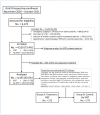Blood Transfusions and Adverse Events after Colorectal Surgery: A Propensity-Score-Matched Analysis of a Hen-Egg Issue
- PMID: 36900095
- PMCID: PMC10000587
- DOI: 10.3390/diagnostics13050952
Blood Transfusions and Adverse Events after Colorectal Surgery: A Propensity-Score-Matched Analysis of a Hen-Egg Issue
Abstract
Blood transfusions are considered a risk factor for adverse outcomes after colorectal surgery. However, it is still unclear if they are the cause (the hen) or the consequence (the egg) of adverse events. A prospective database of 4529 colorectal resections gathered over a 12-month period in 76 Italian surgical units (the iCral3 study), reporting patient-, disease-, and procedure-related variables, together with 60-day adverse events, was retrospectively analyzed identifying a subgroup of 304 cases (6.7%) that received intra- and/or postoperative blood transfusions (IPBTs). The endpoints considered were overall and major morbidity (OM and MM, respectively), anastomotic leakage (AL), and mortality (M) rates. After the exclusion of 336 patients who underwent neo-adjuvant treatments, 4193 (92.6%) cases were analyzed through a 1:1 propensity score matching model including 22 covariates. Two well-balanced groups of 275 patients each were obtained: group A, presence of IPBT, and group B, absence of IPBT. Group A vs. group B showed a significantly higher risk of overall morbidity (154 (56%) vs. 84 (31%) events; OR 3.07; 95%CI 2.13-4.43; p = 0.001), major morbidity (59 (21%) vs. 13 (4.7%) events; OR 6.06; 95%CI 3.17-11.6; p = 0.001), and anastomotic leakage (31 (11.3%) vs. 8 (2.9%) events; OR 4.72; 95%CI 2.09-10.66; p = 0.0002). No significant difference was recorded between the two groups concerning the risk of mortality. The original subpopulation of 304 patients that received IPBT was further analyzed considering three variables: appropriateness of BT according to liberal transfusion thresholds, BT following any hemorrhagic and/or major adverse event, and major adverse event following BT without any previous hemorrhagic adverse event. Inappropriate BT was administered in more than a quarter of cases, without any significant influence on any endpoint. The majority of BT was administered after a hemorrhagic or a major adverse event, with significantly higher rates of MM and AL. Finally, a major adverse event followed BT in a minority (4.3%) of cases, with significantly higher MM, AL, and M rates. In conclusion, although the majority of IPBT was administered with the consequence of hemorrhage and/or major adverse events (the egg), after adjustment accounting for 22 covariates, IPBT still resulted in a definite source of a higher risk of major morbidity and anastomotic leakage rates after colorectal surgery (the hen), calling urgent attention to the implementation of patient blood management programs.
Keywords: anastomotic leakage; blood transfusion; colorectal surgery; morbidity; mortality; transfusion hazards.
Conflict of interest statement
Catarci reports personal fees from Baxter Spa outside the submitted work. Guadagni, Masedu, Montemurro, Ciano, Benedetti, Delrio, Garulli, Pirozzi, Scatizzi, and all other co-authors have no competing interests to declare.
Figures


References
-
- Muñoz M., Acheson A.G., Auerbach M., Besser M., Habler O., Kehlet H., Liumbruno G.M., Lasocki S., Meybohm P., Rao Baikady R., et al. International consensus statement on the peri-operative management of anaemia and iron deficiency. Anaesthesia. 2017;72:233–247. doi: 10.1111/anae.13773. - DOI - PubMed
LinkOut - more resources
Full Text Sources

